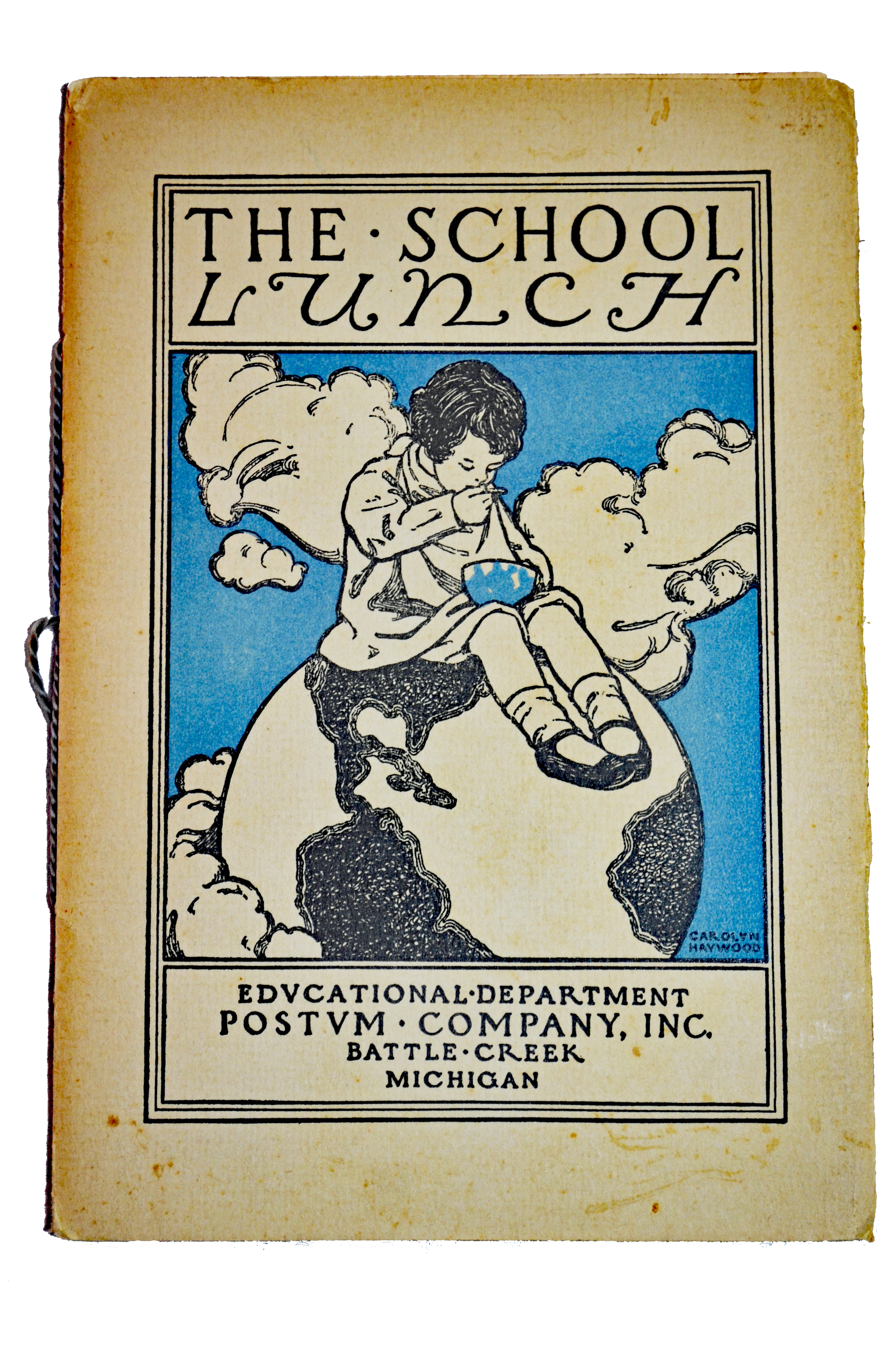The School Lunch
The School Lunch, Educational Department, Postum Company Inc. 1928
This little book, “The School Lunch”, written in 1928, belonged to my great grandmother. It is a glimpse into past education of nutrition and how there was a genuine interest in the health of students. This book explains how important it is for:

“arousing in boys and girls alike an interest in food and its relation to health and for giving them information which will enable them to choose suitable and adequate diets for themselves and for others for whom they may be responsible.” The School Lunch
Well Said!
This is both so true and so inspiring. Before the days of big food, big pharma, big government, and greed were days when people sought to teach young children, not only academics, but the important role foods plays in keeping the body healthy and active. Without proper nutrition we become tired, sick, and unable to keep up with daily activities. It seems pretty obvious to me that incorporating general knowledge on how to Eat Right into our children’s educations is super important.
The book opens with:
“The serving of a hot lunch at school has amply justified itself in all cases where it has been given a fair trial.”. The School Lunch
This is so true. And the hot lunches back in the 1920’s and 1930’s did not include pizza, hotdogs, cheeseburgers or the other so-called foods we find on our children’s school lunch plates. One hundred years ago, meals were naturally made with real foods. There was no concern about whether or not foods were organic or made with GMO’s.
“In order that the school lunch may have a permanent value, the child must be given information in nutrition which will make him generally intelligent about the whole subject of food and its relation to health.” The School Lunch
Wow! It would be awesome if we incorporated even a modicum of nutrition education (healthy eating of real foods) in our children’s schooling.
According to The School Lunch:
“The body needs at least three classes of foods:
Foods to build new tissue and to repair worn tissue.
Foods to regulate the body processes.
Foods to provide sufficient energy for all the activities of the body.”
Learning to feed ourselves properly is one of the most important things we can do for a quality life. It is the way to end epidemic levels of autoimmune disorders, digestive disorders, certain cancers, and other chronic conditions. If we continue to ignore this obvious situation: poor diet = poor health, we will continue to pass on not only these incorrect eating habits to the next generation, but flawed DNA due to our poor eating habits.
According to this study:
“The risk of obesity, metabolic syndrome, and other complications is increased by a variety of common genetic variants, and many of these are associated with specific eating behaviors.”
And this study states:
“Since the information encoded upon DNA is passed from parent-to-child and even potentially from parent-to-grandchild, cells that learn bad habits like ignoring signs of infection or over-reacting to antigens could combine with microbiome shifts to further worsen a child’s immunologic development.”
As I sat reading this book, I was amazed to find how much scientists knew about our nutrient needs back then. There were a few things that have changed, but they mostly had it right. Fortunately, people didn’t have the convenience of processed foods and easy access to sugar to mess up their bodies. This little book is only 32 pages long but, amazingly filled with well-intentioned, healthy, and mostly accurate information for teachers and parents on the importance of feeding children healthy meals and school lunches.
“If the food materials eaten contain tissue-building factors, well and good, the body can use these for that particular purpose. If the food materials eaten do not contain tissue-building factors, no tissue can be built no matter how much of the food is eaten. Or suppose that the food eaten does not supply the special regulatory factors (vitamins), then in spite of all the other food elements which it may contain, the body will begin to slow in one way or another.” The School Lunch
If nutrients are not consumed, cells break down. When cells break down, illness sets in. Our bodies are like dominoes; when one area fails, another is sure to follow until the root cause is addressed. Typically, the true root cause of most disease is lack of nutrients.
Mental health issues can also be addressed with proper nutrition. Let’s face it: we are not deficient in Lexapro, Zoloft, Prozac, or Paxil, (I know this is cliché and many people take issue with this comparison, but it is true. I’ve been saying this for 20yrs). Rather we are deficient in many necessary nutrients: Vitamin B’s (B12 and folate especially), Vitamin D, and magnesium to name just a few. A diet lacking in these nutrients will contribute greatly to depression and anxiety.
According to Citizens Commission on Human Rights International there are 8,389,034 kids ages 0-17 years of age on psychiatric drugs. Eight Million, Three Hundred, Eighty-Nine Thousand, Thirty-Four. That’s a whole lotta kids on drugs. Drugs that cause serious side-effects.
We have to ask ourselves why, today so many children are taking these drugs compared to 50 years ago? We have to look at the connection between the way children (and adults) ate 50+ years ago vs. how we eat today. We have to consider how these drugs affect the growing brain and the terrible side affects these drugs cause. A diet deficient in nutrients is a diet that will fail the body and mind.
“But it was also observed that the animals while on a deficient diet did not develop these diseases suddenly, but that they gradually grew irritable, showed unusual signs of ill-temper or fear, became shabby and listless. Their deficient diet robbed them of good nature, courage, energy and interest in their normal activities long before the appearance of a particular disease.” The School Lunch
Wow! Remember, these studies took place back in the early 1900’s. Before the days of treat-everything-with-pills was prominent. When our diets lack nutrients our brains suffer just as much as other organs in our bodies. For years, psychologists and psychiatrists have stated that diet doesn’t matter when dealing with mental health (I’ve had several say it to me about my son back in the 90’s, and thankfully, I knew they were, excuse me, full of s***, and I ignored their ridiculous diatribe against nutrition). Too bad they weren’t aware of these studies!
“This is the most valuable lesson which we learn from these tests, for they show beyond doubt that among human beings, as well, diets deficient in any factor (whether vitamins, protein, minerals or total amount of energy supplied) are responsible for much nervousness, fear, ill-nature, lack of self-control, lack of ambition and interest in work, lack of appetite, as well as lack of resistance of the body to infections.” The School Lunch
Interestingly, this book was written by the “Postum Company Inc”. So, while it was serving a purpose; educating teachers on the importance of healthy foods for kids, it was also an advertisement! In the back of the book, the Postum Company lists a few of their products: Grape-Nuts, Bran Flakes, Minute Tapioca etc. Plus several recipes.
It was fun finding and reading this book. Also a bit unexpected. I opened it, expecting to read archaic advice and notions on how to feed kids. I came away being more determined then ever to spread the word on how important it is that we get back to eating real foods. We started off last century with the right information and advice. At some point, mid-century, our government allowed big business to take over the control of our food and we as a society started losing our health. We really need to take it back. We need to Eat Right for our future generations, and teach our children what real food looks and tastes like!
Sources:
Postum Company Inc, Educational Department, The School Lunch, Battle Creek, 1928. Print. https://www.ncbi.nlm.nih.gov/pmc/articles/PMC3052625/
https://www.ncbi.nlm.nih.gov/pmc/articles/PMC4074336/
https://www.cchrint.org/psychiatric-drugs/children-on-psychiatric-drugs/

